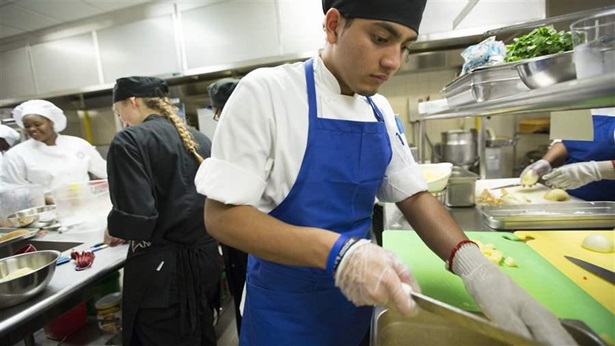Peer and Community Networks Drive Success in Rural School Meal Programs
Challenges and strategies for meeting students’ nutritional needs in remote areas
Overview
More than half of public school districts in the United States are in rural communities where millions of students struggle with poverty and hunger. According to the U.S. Department of Agriculture, 24 percent of rural children lived in poverty and 686,000 rural households with children were food insecure in 2014. About 95 percent of rural schools participate in the National School Lunch Program, and many also operate federally funded breakfast and snack programs. But because of their remote locations and smaller populations of students and potential employees, these districts face acute challenges in delivering healthy meals.
To explore the issues that rural school nutrition professionals, particularly those in small districts, confront in ensuring that all students in need receive healthy meals, the Kids’ Safe and Healthful Foods Project—a joint initiative of The Pew Charitable Trusts and the Robert Wood Johnson Foundation—commissioned an in-depth study of rural district meal programs. The analysis also examined the evidence-based strategies and practices that can lessen or remove those hurdles.
The study used the National Center for Education Statistics’ definition of “rural.” The center assigns each district to one of four categories—city, suburb, town, or rural—based on proximity to a Census Bureau-defined urban center. Information from two nationally representative surveys of school districts was used to define “small” districts as those with fewer than 2,500 students. Researchers conducted a literature review of peer-reviewed studies and government reports on rural school meal programs; interviews with rural education or nutrition experts, and school food program directors; and focus groups with directors in Indiana, Louisiana, and Texas. Additionally, more than 50 rural school nutrition experts, including leaders from the education, government, industry, and nonprofit sectors, gathered in September 2016 to review the findings and develop recommendations for policymakers at the federal, state, and local levels.
The project’s analysis identified five challenges that, while not unique to rural districts, factor heavily in the success of their nutrition programs and examined the strategies these districts use to overcome the challenges they face:
- Administrative capacity. A common issue, especially in very small rural districts, is the limited number of nutrition staff available to perform the administrative duties associated with operating a school meal program, including purchasing, invoicing, and creating menus. Peer networking, external consultants, and effective use of technology can help districts overcome limited staff capacity.
- Qualified staff. Recruiting experienced nutrition staff can be difficult in rural districts, which tend to have fewer qualified people in the labor pool compared with larger, urban areas. Training staff can be difficult in rural settings, where school nutrition personnel often have responsibilities outside of meal program operations and may have difficulty finding time for professional development. Many rural districts address these potential barriers by working with nearby higher education institutions to promote school nutrition careers and adapt training formats for staff members who cannot travel long distances for in-person professional development.
- Dispersed student population. Bus rides of up to two hours each way limit the time students have to eat during the school day, especially at breakfast. Some districts are using inventive serving strategies, such as “breakfast-after-the-bell” and “grab-and-go” options, to expand student access to school meals and give students more time to eat.
- Food and supply options. Because of their remote locations, many rural districts have difficulty finding vendors that offer desirable delivery schedules; competitive prices; and high-quality food, supplies, and equipment. Forming or joining purchasing cooperatives, sourcing locally, and collaborating with community businesses help rural districts purchase products to meet their requests.
- Equipment and infrastructure. Many schools nationwide serve meals in outdated kitchens, but rural districts tend to suffer most acutely from some of the problems associated with old infrastructure, such as lack of storage space to accommodate the larger quantities of fruits and vegetables that schools are serving. Pursuing public or private grants and seeking community support in the form of matching funds or grant-writing assistance can enable rural school nutrition programs to overcome kitchen equipment and infrastructure limitations.
Although this research focused on the problem areas listed above, it also found that certain characteristics of rural schools and communities could help student meal programs tackle these challenges. Attendees at the 2016 convening and focus group participants indicated that smaller student populations and less administrative bureaucracy and organizational complexity can allow rural schools to implement changes, such as modified lunch and recess schedules to give students more time to eat, more easily than larger districts.
This report examines the results of the study and outlines strategies that rural districts can use to overcome barriers as well as ways that policymakers and national organizations can help:
- School districts and community members can collaborate to share information and resources; attract and retain qualified school nutrition professionals; and purchase, prepare, and serve high-quality food for a rural student population.
- Professional organizations for school nutrition workers and nonprofits with an interest in children’s health can facilitate networking and training opportunities for rural school meal programs.
- Local, state, and federal policymakers can expand funds for technology and kitchen upgrades, and provide technical assistance to ensure that rural districts have the resources they need.
With support from all levels of government and their local communities, rural school meal programs can build on the creative strategies they are already using to provide healthy, appealing foods that meet their students’ nutritional needs.


America’s Overdose Crisis
Sign up for our five-email course explaining the overdose crisis in America, the state of treatment access, and ways to improve care
Sign up

How Schools Are Getting Kids to Eat Healthy Foods
New report reveals strategies for successful meal programs


Neighborhoods Benefit From Access to School Kitchens
Making facilities available to the public promotes health, community engagement










